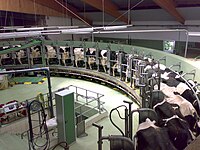
Photo from wikipedia
The physiology of the dairy cow while transitioning from pregnancy to lactation is complex, with multifactorial processes studied extensively for the role they play in manifestation of disease along with… Click to show full abstract
The physiology of the dairy cow while transitioning from pregnancy to lactation is complex, with multifactorial processes studied extensively for the role they play in manifestation of disease along with associated economic losses and compromised animal welfare. Manuscripts outlining associations among nutrition, production, physiology, and genetics variables and transition cow disorders are common in literature, with blood analytes that are central to energy metabolism (e.g., nonesterified fatty acids; NEFA, β-hydroxybutyrate; BHB) often reported. Immunity and inflammation have increasingly been explored in the pathogenesis and persistence of disorders, with cytokines and acute phase proteins well documented. However, most of these studies have involved cows fed total mixed rations, which may not always reflect profiles of blood analytes and other physiological indicators of transition cow health in grazing cows consuming fresh pasture. Considering the comparatively lesser characterization of these analytes and markers in pasture-based, seasonal-calving dairy cows, we compiled a database consisting of 2,610 cow lactations that span 20 yr of transition cow research in New Zealand. Using this database, analyte profiles from approximately 28 d precalving to 35 d postcalving were identified in dairy cows with a range of genetics, milk production potentials, and pasture-based farm management systems. These profiles characterize changes in energy reserves and metabolism (NEFA, BHB, glucose, insulin, growth hormone, insulin-like growth factor-1, leptin, body condition score, body weight), liver function (globulin, aspartate aminotransferase, glutamate dehydrogenase, gamma-glutamyl transpeptidase, bilirubin, cholesterol, liver triacylglycerides), protein metabolism (albumin, total protein, albumin:globulin ratio, creatinine, urea, creatine kinase), mineral balance (calcium, magnesium, phosphate, potassium, sodium, chloride, bicarbonate), inflammation (IL-1β, IL-6, haptoglobin, reactive oxygen species, total antioxidant capacity), and uterine health (polymorphonuclear cells, macrophage cells, vaginal discharge score). Temporal changes are generally consistent with previously characterized homeorhetic changes experienced by the dairy cow during the transition from pregnancy to lactation in both pastoral and housed systems. Some of the profiles had not previously been presented for pastoral systems, or in some cases, presented for either system. Our results indicate that moderate-yielding dairy cows undergo similar homeorhetic changes to high-yielding housed cows; however, differences in diet composition result in greater BHB concentrations than expected, based on their milk production and NEFA concentrations. In addition, most cows were able to transition to a state of higher energy requirement following calving, albeit with an increased metabolic challenge in the liver, and only a small percentage of cows were classified with severe hepatic lipidosis or severe hyperketonemia. Increases in metabolic function of the liver were accompanied by changes in indicators of the immune system and changes in mineral balance that, combined, probably reflect the innate response to the transition from gestation to lactation.
Journal Title: Journal of dairy science
Year Published: 2022
Link to full text (if available)
Share on Social Media: Sign Up to like & get
recommendations!